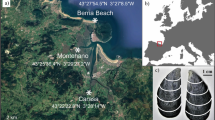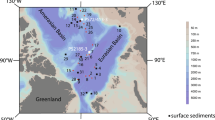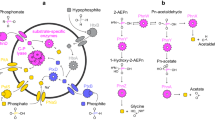Abstract
DATING of deposits and materials less than 350 years old is hindered by the very poor time resolution of the radiocarbon method over this period1,2. Fluctuations in atmospheric 14C levels result in the existence of several possible calendric ages for any given radiocarbon age for terrestrial samples. In the marine record, these fluctuations are dampened. However, only a small change in marine radiocarbon ages occurs over this period (from AD 1700 to 1950, radiocarbon ages become only 100 yr younger2). Consequently, age resolution is poor. Furthermore, there is an uncertainty in the amount of the correction for the reservoir effect, the apparent radiocarbon age of modern marine carbon (typically ~400yr), which reflects the average residence time of carbon in the oceans. Amino-acid racemization/epimerization analysis has been used primarily for dating samples older than the limit of radiocarbon dating (40,000–50,000 yr BP)3,4. Here I show that aspartic acid (Asp) in mollusc shells has racemized particularly rapidly over the past few centuries. Analyses done on land snails from deposits in the Negev Desert, eolianites in Madeira, cave deposits in Jamaica and from museum collections indicate racemization rates of 2–5% per century. Asp racemization thus provides a means of dating recent faunal assemblages of molluscs and other biogenic carbonates, as well as recent terrestrial, fluvial and marine sedimentary sequences that contain molluscs.
This is a preview of subscription content, access via your institution
Access options
Subscribe to this journal
Receive 51 print issues and online access
$199.00 per year
only $3.90 per issue
Buy this article
- Purchase on Springer Link
- Instant access to full article PDF
Prices may be subject to local taxes which are calculated during checkout
Similar content being viewed by others
References
Stuiver, M. & Pearson, G. W. Radiocarbon 28, 805–838 (1986).
Stuiver, M., Pearson, G. W. & Braziunas, T. F. Radiocarbon 28, 980–1021 (1986).
Bada, J. L. A. Rev. Earth planet. Sci. 13, 241–268 (1985).
Wehmiller, J. F. Quat. Sci. Rev. 1, 83–120 (1982).
Bada, J. L. Interdiscip. Sci. Rev. 7, 30–46 (1982).
Helfman, P. M. & Bada, J. L. Nature 262, 279–280 (1976).
Goodfriend, G. A., von Endt, D. W. & Hare, P. E. A. Rep. Director Geophys. Lab. Carnegie inst. Wash. 1990–1991, 172–176 (1991).
Weiner, S., Kustanovich, Z., Gil-Av, E. & Traub, W. Nature 287, 820–823 (1980).
Kvenvolden, K. A., Blunt, D. J. & Clifton, H. E. Geochim. cosmochim. Acta 43, 1505–1520 (1979).
Goodfriend, G. A. Geochim. cosmochim. Acta 55, 293–302 (1991).
Goodfriend, G. A. & Stipp, J. J. Geology 11, 575–577 (1983).
Goodfriend, G. A. Radiocarbon 29, 159–167 (1987).
Avitsur, S. Proc. Israeli Geogr. Soc. Ann Meeting (in Hebrew) 11–17 (Department of Geography, Ben Gurion Univ., Beer Sheva, 1977).
Goodfriend, G. A. & Meyer, V. R. Geochim. cosmochim. Acta 55, 3355–3367 (1991).
Lajoie, K. R., Wehmiller, J. F. & Kennedy, G. L. in Biogeochemistry of Amino Acids (eds Hare, P. E., Hoering, T. C. & King, K. Jr) 305–340 (Wiley, New York, 1980).
Kaufman, D. S. Geol. Soc. Am. Bull. 104, 40–52 (1992).
Miller, G. H. & Hare, P. E. in Biogeochemistry of Amino Acids (eds Hare, P. E., Hoering, T. C. & King, K. Jr) 415–443 (Wiley, New York, 1980).
Goodfriend, G. A. Quat. Res. 28, 374–392 (1987).
Goodfriend, G. A. & Mitterer, R. M. Palaeogeogr. Palaeoecol. Palaeoclim. 63, 293–311 (1988).
Goodfriend, G. A. Radiocarbon 31, 1041–1047 (1989).
Miller, G. H. et al. Nature 326, 593–595 (1987).
Abdalla, S., Bayer, E. & Frank, H. Chromatographia 23, 83–85 (1987).
Stuiver, M. & Kra, R. (eds) Radiocarbon 28(2B) (1986).
Goodfriend, G. A. & Mitterer, R. M. Geol. Soc. Am. Bull. (in the press).
Author information
Authors and Affiliations
Rights and permissions
About this article
Cite this article
Goodfriend, G. Rapid racemization of aspartic acid in mollusc shells and potential for dating over recent centuries. Nature 357, 399–401 (1992). https://doi.org/10.1038/357399a0
Received:
Accepted:
Issue Date:
DOI: https://doi.org/10.1038/357399a0
This article is cited by
-
Detection of diastereomer peptides as the intermediates generating d-amino acids during acid hydrolysis of peptides
Amino Acids (2016)
-
Contrasting sedimentation rates in Lake Illawarra and St Georges Basin, two large barrier estuaries on the southeast coast of Australia
Journal of Paleolimnology (2011)
-
Amino acid dating of recent intertidal sediments in the Wadden Sea, Germany
Senckenbergiana maritima (2003)
-
Desertification in Northern Sinai in the eighteenth century
Climatic Change (1995)
-
Racemization rates of amino acids for dating ancient samples
Amino Acids (1993)
Comments
By submitting a comment you agree to abide by our Terms and Community Guidelines. If you find something abusive or that does not comply with our terms or guidelines please flag it as inappropriate.



